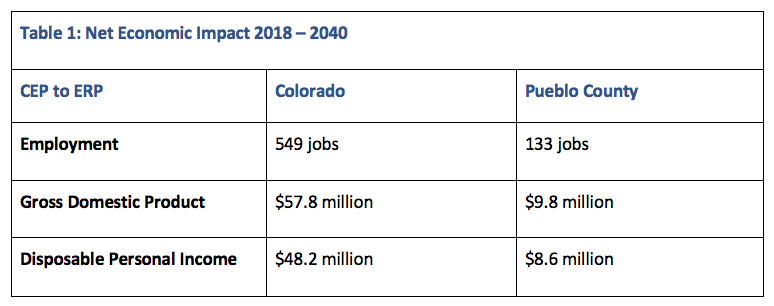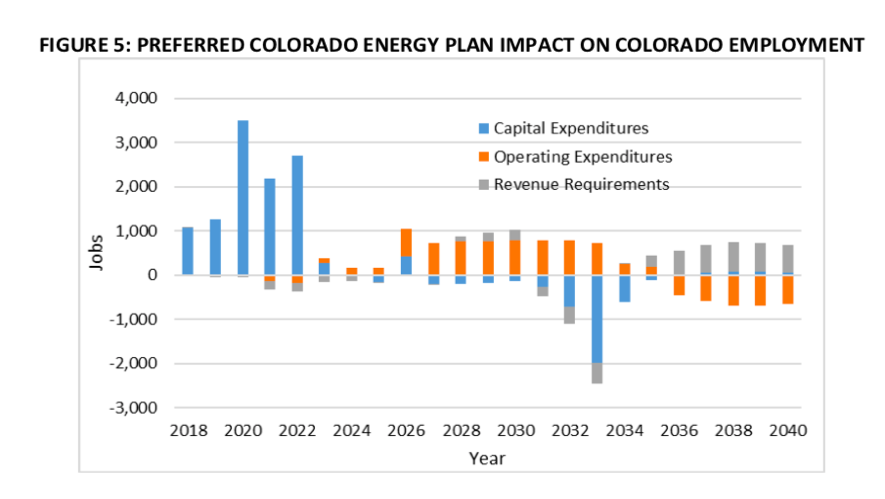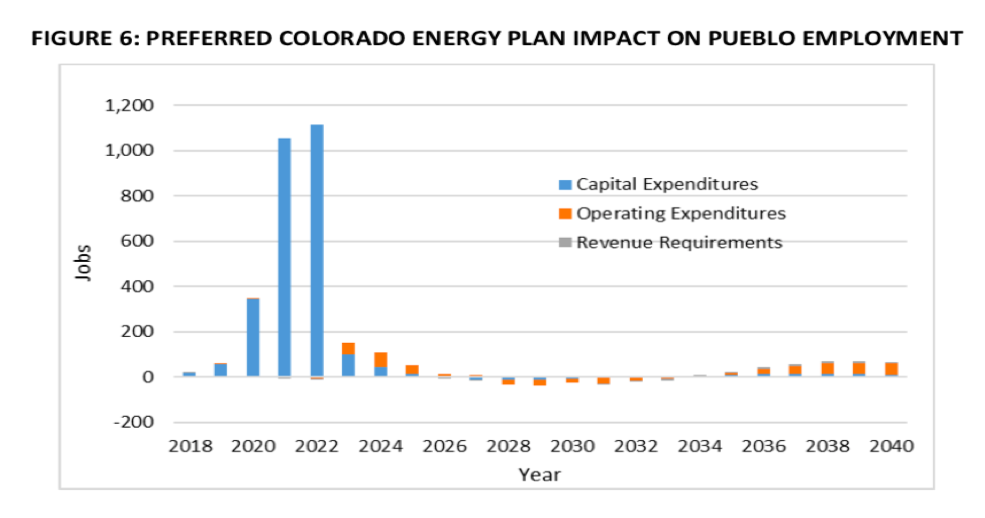

The Colorado Energy Plan (CEP) proposed by Xcel Energy as part of their 2016 Electric Resource Plan (ERP) aims to advance a clean energy future for Colorado. Every four years, regulated utilities in Colorado are required to submit an ERP to evaluate the future electric demands of their customers and determine the energy resource best suited to meet that demand. ERPs are submitted to and approved by the Colorado Public Utilities Commission (PUC). Xcel’s 2016 Electric Resource Plan determined Colorado will need an additional 600 megawatts (MW) of energy capacity by 2023 for reference, approximately 1 MW of energy per 1,000 homes. This means Colorado needs enough energy to power approximately 600,000 additional homes by 2023.
The CEP recommends a two-part solution to meet the 600 MW demand. First, two coal-fired power plants — Comanche 1 and 2, in Pueblo County — will be taken out of service. The plants are currently set to be retired in 2033 and 2035, but the CEP would accelerate the retirements by ten years to 2022 and 2025. Comanche 1 and 2 have a combined capacity of 660 MW, approximately one third of Xcel’s remaining coal resources. Second, Xcel plans to replace the lost capacity from the early retirement of Comanche 1 and 2 with a mixture of renewable resource and natural gas, including development of 1,100 MW of new wind production, 700 MW of new solar, 275 MW of battery storage, and purchase of 380 MW of existing natural gas facilities. The investment in eight Colorado communities is expected to reach $2.5 billion. The CEP expects to provide benefits across Colorado, taking advantage of both new and existing infrastructure to provide reliable, accessible, and affordable clean energy to Colorado consumers.

120-Day Report
The Colorado Energy Plan charts a bold new approach to provide energy to Colorado’s growing population and increasing demand for electricity. As with any project, it has many uncertainties and unanswered questions. Pueblo County, for example, is dependent on Comanche 1 and 2 for jobs and economic stability. The early retirement of the coal plants will result in the loss of approximately 80 long-term jobs, slightly less than half of the plant’s current employment of 170. Before moving forward with the plan, the Colorado Public Utilities Commission needs to determine if the investments in renewable energy will produce enough economic growth, jobs, energy access and affordability, and environmental and social benefits to offset the loss of jobs and reduction in stability for Pueblo County and the state.
To answer these difficult questions, Xcel took several strategic steps, including conducting an economic impact analysis for Colorado and Pueblo County. The economic impact analysis identified changes in employment (number of jobs), gross domestic product (GDP), and disposable personal income caused by the accelerated retirement of the coal-fired plants and replacement of the lost capacity with renewable energy. As a baseline for comparison, the analysis used the Preferred ERP–an alternative scenario wherein the coal plants are not retired early, but Xcel still invests in a mixture of renewables and natural gas to meet the 600 MW need. By comparing the CEP to the preferred ERP, the study is better able to determine the economic impact of decommissioning the coal plants and investing in renewable energy. The analysis considered the economic changes and corresponding impacts between 2018 and 2040, allowing the 23-year study period to consider both short-and long-term economic impacts. Using capital expenditures, operating expenses, and revenue requirements, the analysis determined the projected economic impact of the CEP.
The analysis made the following assumptions about economic activity in Colorado and Pueblo County when determining the outcomes:
An increase in capital expenditures like an investment in a solar or wind farm, increases economic activity.
A decrease in operating expenditures below the preferred ERP such as a decrease in transportation or material costs, decreases economic activity.
A decrease in the revenue requirement the amount of capital needed to meet the costs of providing electricity to customers reduces the costs to ratepayers.
Overall, the analysis found the CEP results in net positive economic benefits. The benefits are attributed to a net increase in capital expenditures and operating expenses and a net decrease in revenue requirements. Assuming the Colorado PUC decides to allow Xcel Energy to adopt and implement the CEP, the estimates reflect the retirement of Comanche 1 and 2 and investments in the previously discussed renewable sources. Table 1 below shows the average increase in jobs, GDP, and disposable personal income. We can interpret these estimates to mean that from 2018-2040 Colorado would see on average of 549 more jobs compared to the baseline ERP scenario and of those 133 are in Pueblo County. The same can be said for GDP and Disposable Personal Income of those workers.

Determining how the scope, magnitude, and more importantly, the proposed change in the way energy is produced in Colorado will impact communities, requires looking at many variables. Economic impact analyses measure how spending flows when it is moved from one industry to another like from fossil fuels to renewable energy. It does not measure the benefits and costs of a project like improved system efficiency or environmental and social benefits. To understand the broader effects and long-term sustainability of an investment like the CEP, it is important to look beyond overall economic impacts.
The overall economic impact indicates the potential number of jobs created under a specific set of assumptions, but it does not provide information about the characteristics of those jobs: how many are temporary or ongoing, how many workers need to be retrained or relocated, or the types of jobs. For example, when considered separately, short-and long-term effects tell two different stories. In the first five years of the CEP, Colorado and Pueblo County are expected to experience a large influx of investment dollars. This artificially inflates the overall impact as illustrated in Figure 5 and 6.

Leeds School of Business Economic Impact Analysis

Leeds School of Business Economic Impact Analysis
In Pueblo County, the significant increase in jobs is likely to be attributed to the temporary or construction-based nature of jobs created by capital expenditures. A large influx in capital expenditures in 2018 might yield positive short-term economic impacts, but they will dissipate quickly, whereas a decrease in operating expenses from the new investments will be felt in the long-term. By looking at the average number of jobs for the first five years and comparing them to the average number of jobs in the last 18 years of the study, we can see the difference between short-and long-term jobs. The average number of jobs produced in Pueblo County in the first five years of the proposed project is three times the average number of jobs produced in the last 18 years of the study. That means that while there is substantial short-term job growth, the long-term impact to employment remains only slightly above the baseline ERP scenario.
GDP is the most common measure of economic prosperity. Typically, GDP growth is considered positive and a reduction in GDP is negative. Because GDP is the equivalent of dollars being spent in an economy, it fails to capture other aspects like health or environmental factors. The economic analysis estimates Colorado’s GDP would increase by an average of $57.8 million per year and Pueblo County’s would rise $9.8 million over 23 years. These fiscal impacts are relatively small in the overall economy representing a 0.01 percent change in Colorado’s $343 billion economy and 0.016 percent change in Pueblo’s $4.9 billion economy (See: Xcel Energy’s 120-Day Report[1] [2]). As with employment, the majority of these increases are seen in the first five years.
Maintaining ratepayer costs is essential, specifically when considering impacts to working families. With the cost of developing renewable energy competitive with fossil fuels, the study estimates revenue requirements would decrease by $431.5 million. Revenue requirements are one method to determine whether rates will increase or decrease. Though this may appear to be a significant change, it represents a 0.8 percent change compared to the baseline ERP. Xcel estimates the CEP will save approximately $213 million (120-Day Report); however, it has not yet been confirmed whether this translates to an increase, decrease, or neutral impact for rates for the average Xcel customer and working families.
The economic impact is an important component when discussing the benefits and costs of the CEP. Economic impact analyses can provide valuable information and guidance about things that are easily counted like the number of jobs created or lost, but these figures do not tell the entire story. The economic impact analysis concludes that the net positive growth in job creation, GDP, and disposable personal income is better for the overall economy, but to be confident with the CEP, decision makers should also consider the environmental and social implications of the plan. This can help consumers to better understand the benefits and costs of the CEP.
When you pay your utility bill, you are directly paying for the price of energy, but with all types of energy, including renewables, there are externalities (additional costs and benefits) not included in the price you pay. Externalities can be positive or negative. Negative externalities include: water or air pollution, land degradation, resource limitations, decrease in aesthetic value, or social impacts like damages to public health. Positive externalities include improved environmental and health conditions. Externalities (costs or benefits) are not calculated in an economic impact analysis.
Coloradans want clean energy at a reasonable cost. By replacing coal-fired power with cleaner renewable sources, Xcel projects to reduce Colorado’s carbon dioxide emissions by as much as 60 percent and sulfur dioxide and nitrogen oxide emissions by up to 90 percent from 2005 levels by 2026 (120-Day Report). However, these estimates reflect only one phase of the system life cycle. Once in operation, wind and solar facilities do not emit greenhouse gases, but manufacturing, transportation, installation, maintenance, and decommission phases of the system life cycle involve energy use, part of which comes from fossil fuel combustion. One method to examine the overall energy use of a resource is to determine the net energy ratio of a proposed investment. Net energy ratios (NERs) are the relationship of useful energy output to the grid to the fossil or nuclear energy consumed during the lifetime of the project. Basically, NERs determine whether the amount of fossil fuels that go into producing a wind turbine or solar panel is offset by the emission free energy produced. For renewable energy resources, NERs are expected to be greater than one, indicating a positive return over fossil fuel energy, which have average estimates of 0.3 and 0.4 for coal and natural gas. NERs give a clearer picture of the lifetime sustainability or overall energy use of the resource.
Additionally, renewable energy can be viewed as unpredictable and inconsistent. For this reason, renewables are need battery storage to produce large quantities of energy in the same way as fossil fuels. To meet current and future capacity needs, efficiency will need to be improved or more energy facilities including battery storage will need to be built. The CEP includes 275 MW of battery storage further accounting for increasing the reliability of the renewable energy investments. The National Renewable Energy Laboratory (NREL) estimates that 32 acres of solar energy needed to power 1,000 homes. The land needed to produce solar and wind energy is substantially more than what is needed to produce fossil fuel energy. To combat this, the CEP makes investments in two highly cost-effective sources: natural gas and renewables. Xcel Energy views the CEP as an opportunity to diversify their electricity generation mix in a way that simultaneously achieves economic and environmental benefits across the state (120-Day Report). Maintaining a diverse energy mix increases reliability, accessibility, and affordability.
The analysis above works to provide context and consideration to the many variables surrounding a transition from fossil fuels to renewable energy like the one proposed by the CEP. Overall, with consideration given to long-term economic sustainability, environmental improvements, low-income people, and communities of color, the anticipated benefits likely outweigh the costs. Decision makers on this plan, the Colorado Public Utilities Commission, should evaluate impacts on these areas while they are making their decision. before moving forward with a decision. Ratepayers and interest groups should take interest in this forward looking proposal and hold our leaders and utilities to their word for implementation. This will lead to an equitable transition to cleaner energy.



Colorado Fiscal Institute © 2011-2025. All Rights Reserved. Privacy Policy